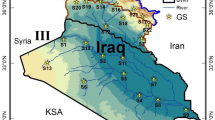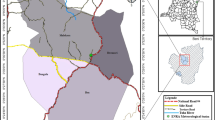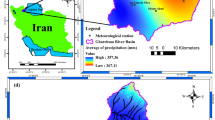Abstract
In this study, 60-year monthly rainfall data of Bangladesh were analysed to detect trends. Modified Mann–Kendall, Spearman’s rho tests and Sen’s slope estimators were applied to find the long-term annual, dry season and monthly trends. Sequential Mann–Kendall analysis was applied to detect the potential trend turning points. Spatial variations of the trends were examined using inverse distance weighting (IDW) interpolation. AutoRegressive integrated moving average (ARIMA) model was used for the country mean rainfall and for other two stations data which depicted the highest and the lowest trend in the Mann–Kendall and Spearman’s rho tests. Results showed that there is no significant trend in annual rainfall pattern except increasing trends for Cox’s Bazar, Khulna, Satkhira and decreasing trend for Srimagal areas. For the dry season, only Bogra area represented significant decreasing trend. Long-term monthly trends demonstrated a mixed pattern; both negative and positive changes were found from February to September. Comilla area showed a significant decreasing trend for consecutive 3 months while Rangpur and Khulna stations confirmed the significant rising trends for three different months in month-wise trends analysis. Rangpur station data gave a maximum increasing trend in April whereas a maximum decreasing trend was found in August for Comilla station. ARIMA models predict +3.26, +8.6 and −2.30 mm rainfall per year for the country, Cox’s Bazar and Srimangal areas, respectively. However, all the test results and predictions revealed a good agreement among them in the study.










Similar content being viewed by others
References
Ahasan MN, Chowdhary Md AM, Quadir DA (2010) Variability and trends of summer monsoon rainfall over Bangladesh. J Hydrol Meteorol 7(1):1–17
Ahmad I, Tang D, Wang T, Wang M, Wagan B (2015) Precipitation trends over time using Mann–Kendall and Spearman’s rho tests in swat river basin, Pakistan. Adv Meteorol. doi:10.1155/2015/431860
Ahmed R (1989) Probabilistic estimates of rainfall extremes in Bangladesh during the pre-monsoon season. Indian Geogr J 64:39–53
Ahmed R, Karmakar S (1993) Arrival and withdrawal dates of the summer monsoon in Bangladesh. Int J Climatol 137(7):727–740
Ahmed R, Kim I-K (2003) Patterns of daily rainfall in Bangladesh during the summer monsoon season: case studies at three stations. Phys Geogr 24(4):295–318
Bari SH, Rahman MT, Hussain MM, Ray S (2015) Forecasting monthly precipitation in Sylhet city using ARIMA model. J Civ Environ Res 7(1):69–78
Basak JK, Ali MA, Islam MN, Rashid MA (2010) Assessment of the effect of climate change on boro rice production in Bangladesh using DSSAT model. J Civ Eng 38:95–108
Bayazit M, Önöz B (2008) To prewhiten or not to prewhiten in trend analysis? Hydrol Sci J 52(4):611–624
Blain GC (2013) The Mann–Kendall test: the need to consider the interaction between serial correlation and trend. Agr Eng 35(4)
Box GEP, Jenkins GM (1976) Time series analysis: forecasting and control. Holden-Day, Boca Raton
Buishand TA (1982) Some methods for testing the homogeneity of rainfall records. J Hydrol 58(1):11–27
Chowdhury MHK, Pramanik MAH, Quadir DA, Nazlee F (2006) Study of meteorological parameter related to climate variability in Bangladesh. Atmosphere 3:71–88
Das Gupta A, Singh Babel M, Albert X, Mark O (2005) Water sector of Bangladesh in the context of integrated water resources management: a review. J Water Resour D 21(2):385–398
Dietz EJ, Killeen TJ (1981) A nonparametric multivariate test for monotone trend with pharmaceutical applications. J Am Stat Assoc 76(373):169–174
Esteban-Parra MJ, Rodrigo FS, Castro-Díez Y (1995) Temperature trends and change points in the northern Spanish plateau during the last 100 years. Int J Climatol 15(9):1031–1042
Hamed KH, Ramachandra Rao A (1998) A modified Mann–Kendall trend test for autocorrelated data. J Hydrol 204(1–4):182–196
Hans Alexandersson (1986) A homogeneity test applied to precipitation data. Int J Climatol 6(6):661–675
Hirsch RM, Slack JR (1984) A nonparametric trend test for seasonal data with serial dependence. Water Resour Res 20(6):727–732
Hirsch RM, Slack JR, Smith RA (1982) Techniques of trend analysis for monthly water quality data. Water Resour Res 18(1):107–121
Hossain M, Roy K, Datta D (2014) Spatial and temporal variability of rainfall over the south-west coast of Bangladesh. J Clim 2(2):28–46
Hussain AM, Sultana N (1996) Rainfall distribution over Bangladesh stations during the monsoon months in the absence of depressions and cyclonic storms. Mausam 47:339–348
Immerzeel W (2008) Historical trends and future predictions of climate variability in the Brahmaputra basin. Int J Climatol 28(2):243
IPCC (2007) Climate change 2007: impacts, adaptation and vulnerability. In: Parry ML, Canziani OF, Palutikof JP, van der Linden PJ, Hanson CE (eds) Contribution of working group II to the fourth assessment report of the intergovernmental panel on climate change. Cambridge University Press, Cambridge
IPCC (2013) Climate change 2013: the physical science basis. In: Stocker TF, Qin D, Plattner G-K, Tignor M, Allen SK, Boschung J, Nauels A, Xia Y, Bex V, Midgley PM (eds) Contribution of working group I to the fifth assessment report of the intergovernmental panel on climate change. Cambridge University Press, Cambridge
IPCC (2014) Climate change 2014: synthesis report. In: Core Writing Team, Pachauri RK, Meyer LA (eds) Contribution of working groups I, II and III to the fifth assessment report of the intergovernmental panel on climate change. IPCC, Geneva
Islam T, Neelim A (2010) Climate change in Bangladesh: a closer look into temperature and rainfall data. University Press, Dhaka
Islam MN, Uyeda H (2008) Vertical variations of rain intensity in different rainy periods in and around Bangladesh derived from TRMM observations. Int J Climatol 28(2):273–279
Jones P (1999) The instrumental data record: its accuracy and use in attempts to identify the “CO2 signal”. In: Analysis of climate variability. Springer, Berlin, pp 53–76
Karl R, Williams CN Jr (1987) An approach to adjusting climatological time series for discontinuous inhomogeneities. J Clim Appl Meteorol 26(12):1744–1763
Karmakar S, Khatun A (1995) Variability and probabilistic estimates of rainfall extremes in Bangladesh during the southwest monsoon season. Mausam 46(1):47–56
Kendall MG (1975) Rank correlation methods. Griffin & Co, London
Kripalani RH, Sushama I, Sontakke NA (1996) Rainfall variability over Bangladesh and Nepal: comparison and connections with features over India. Int J Climatol 16(6):689–703
Kumar S, Merwade V, Kam J, Thurner K (2009) Stream flow trends in Indiana: effects of long term persistence, precipitation and subsurface drains. J Hydrol 374(1–2):171–183
Lehmann EL, D’Abrera HJ (1975) Nonparametrics: statistical methods based on ranks. Holden-Day, San Francisco
Makokha GL, Shisanya CA (2010) Trends in mean annual minimum and maximum near surface temperature in Nairobi city, Kenya. Adv Meteorol. doi:10.1155/2010/676041
Mann HB (1945) Nonparametric tests against trend. Econometrica 245–259
Matalas NC, Sankarasubramanian A (2003) Effect of persistence on trend detection via regression. Water Resour Res 39(12)
Nalley D, Adamowski J, Khalil B (2012) Using discrete wavelet transforms to analyze trends in stream flow and precipitation in Quebec and Ontario (1954–2008). J Hydrol 475:204–228
Nalley D, Adamowski J, Khalil B, Ozga-Zielinski B (2013) Trend detection in surface air temperature in Ontario and Quebec, Canada during 1967–2006 using the discrete wavelet transforms. Atmos Res 132:375–398
Önöz B, Bayazit M (2012) Block bootstrap for Mann–Kendall trend test of serially dependent data. Hydrol Process 26(23):3552–3560
Peterson TC, Easterling DR, Karl TR, Groisman P, Nicholls N, Plummer N, Torok S, Auer I, Boehm R, Gullett D, Vincent L (1998) Homogeneity adjustments of in situ atmospheric climate data: a review. Int J Climatol 18(13):1493–1517
Radziejewski M, Zbigniew WK (2004) Detectability of changes in hydrological records/Possibilité de détecter les changements dans les chroniques hydrologiques. Hydrol Sci J 49(1):39–51
Rahman MM, Ferdousi N (2012) Rainfall and temperature scenario for Bangladesh using 20 km mesh AGCM. Int J Clim Change Strateg Manag 4(1):66–80. doi:10.1108/17568691211200227
Rahman R, Lateh H (2015) Climate change in Bangladesh: a spatio-temporal analysis and simulation of recent temperature and rainfall data using GIS and time series analysis model. Theor Appl Climatol. doi:10.1007/s00704-015-1688-3
Rahman MR, Salehin M, Matsumoto J (1997) Trends of monsoon rainfall pattern in Bangladesh. Bangladesh J Water Resour 14(18):121–138
Rahman MM, Islam MN, Ahmed AU, Georgi F (2012) Rainfall and temperature scenarios for Bangladesh for the middle of 21st century using RegCM. J Earth Syst Sci 121(2):287–295
Richard SJT (2012) The economic impact of climate change in the 20th and 21st centuries. Clim Change 117(4):795–808
Romilly P (2005) Time series modelling of global mean temperature for managerial decision-making. J Environ Manag 76:61–70
Sanderson M, Ahmed R (1979) Pre-monsoon rainfall and its variability in Bangladesh: a trend surface analysis/Chute des pluis de la pré-mousson et sa variabilité au Bangladesh: tendance d’analyse en superficie. Hydrol Sci J 24(3):277–287
Sen PK (1968) Estimates of the regression coefficient based on Kendall’s tau. J Am Stat Assoc 63(324):1379–1389
Shadmani M, Marofi S, Roknian M (2012) Trend analysis in reference evapotranspiration using Mann–Kendall and Spearman’s rho tests in arid regions of Iran. Water Resour Manag 26(1):211–224. doi:10.1007/s11269-011-9913-z
Shahid S (2010) Rainfall variability and the trends of wet and dry periods in Bangladesh. Int J Climatol 30(15):2299–2313. doi:10.1002/joc.2053
Shahid S (2011) Trends in extreme rainfall events of Bangladesh. Theor Appl Climatol 104:489–499. doi:10.1007/s00704-010-0363-y
Shahid S, Khairulmaini OS (2009) Spatio-temporal variability of rainfall over Bangladesh during the time period 1969–2003. APJAS 45(3):375–389
Sneyers R (1990) On the statistical analysis of series of observations. World Meteorol Organ Tech Note 143:192
Spearman C (1904) The proof and measurement of association between two things. Am J Psychol 15(1):72–101
Sultana N, Hasan MM (2015) Forecasting temperature in the coastal area of Bay of Bengal—an application of Box–Jenkins seasonal ARIMA model. J Civ Environ Res 7(8):149–160
WARPO (2006) Costal development strategy. National Water Management Plan Project, Water Resources Planning Organization (WARPO), Ministry of Water Resources, Government of Bangladesh
Yaseen M, Bhatti HA, Rientjes T, Nabi G, Latif M (2013) Temporal and spatial variations in summer flows of upper Indus Basin, Pakistan. In: Proceedings of the 72nd annual session of Pakistan engineering congress, December, 2013. Paper no. 747, pp 315–334
Yaseen M, Bhatti HA, Rientjes T, Nabi G, Latif M (2014) Assessment of recent temperature trends in Mangla watershed. J Himal Earth Sci 47(1):107–121
Yue S, Pilon P, Cavadias G (2002a) Power of the Mann–Kendall and Spearman’s rho tests for detecting monotonic trends in hydrological series. J Hydrol 259(1):254–271. doi:10.1016/S0022-1694(01)00594-7
Yue S, Pilon P, Phinney B, Cavadias G (2002b) The influence of autocorrelation on the ability to detect trend in hydrological series. Hydrol Process 16(9):1807–1829
Yurekli K, Simsek H, Cemek B, Karaman S (2007) Simulating climatic variables by using stochastic approach. Build Environ 42:3493–3499
Acknowledgments
The authors would like to express their gratitude to Chinese Government Scholarship Council (CSC) and to Nanjing University of Information Science and Technology (NUIST) for different forms of supports. The authors are also thankful to Bangladesh Meteorological Department (BMD) for providing rainfall data for this study.
Author information
Authors and Affiliations
Corresponding author
Additional information
Responsible Editor: A. P. Dimri.
Rights and permissions
About this article
Cite this article
Rahman, M.A., Yunsheng, L. & Sultana, N. Analysis and prediction of rainfall trends over Bangladesh using Mann–Kendall, Spearman’s rho tests and ARIMA model. Meteorol Atmos Phys 129, 409–424 (2017). https://doi.org/10.1007/s00703-016-0479-4
Received:
Accepted:
Published:
Issue Date:
DOI: https://doi.org/10.1007/s00703-016-0479-4




